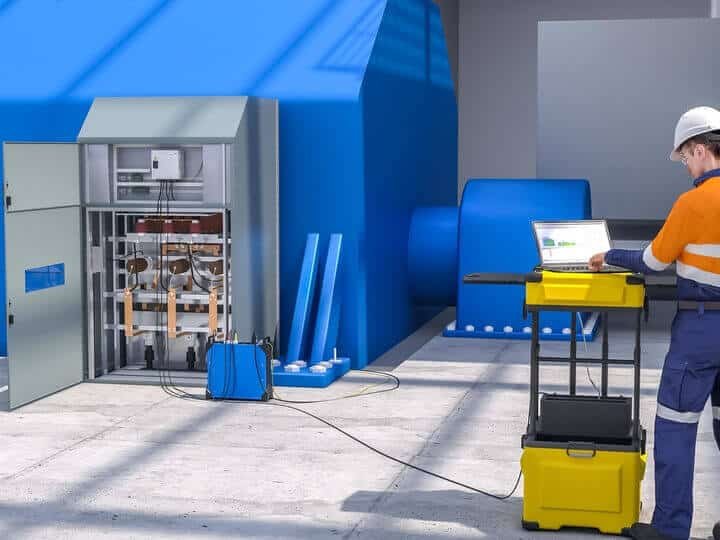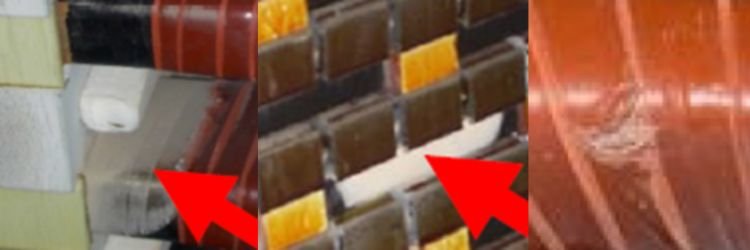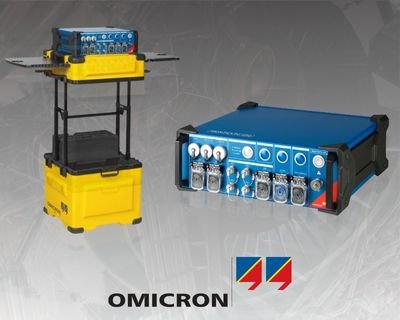What are Partial Discharges? Types and how to control them
For many years, partial discharge (PD) measurement has been used as a means of assessing the quality of new insulation systems and the condition of old insulation systems. It is also considered a means of detecting localized sources of PD in the isolates of transformers, cables and generators arising from operating voltages during their service.
Compared to other dielectric tests (e.g., dissipation factor or insulation resistance measurement), it incorporates two main factors:
- Earlier detection of the defect without apparent damage that has affected the homogeneity of the insulation system, therefore imperceptible to the other tests.
- The differentiating character of partial discharge measurements allows detection of PD sources within the isolation system.
In connection with the maintenance and overhaul of rotating machines, measurement and analysis of partial discharges can also provide information on:
- Presence of points of weakness and possible defects in the isolation system
- Aging processes
- Maintenance measures and service intervals
Online PD measurements are recorded with the machine or asset experiencing all operating stresses; thermal, electrical, ambient and mechanical (TEAM). Therefore, online PD testing has the following advantages:
- The voltage distribution across the winding is the same as during operation.
- Measurements are made at operating temperature.
- Normal mechanical forces are present.
- Cooling conditions and environmental affectation to the insulation system, in different times of the year or climatic transitory situations.
Partial discharges are localized electrical phenomena that occur inside solid insulation of electrical equipment. These discharges, although imperceptible to the naked eye, can be crucial indicators of potential problems in transformers, cables and generators. This phenomenon deserves detailed attention because it can evolve into major failures if not detected and treated in time.
The consequences, if this problem is not solved in time, can be devastating for electrical equipment. From gradual degradation of insulation to excessive heat generation. These events can weaken the integrity of components, affecting the efficiency and reliability of systems, which could result in costly downtime and repairs.
**Team: Nominal operating conditions: temperature, electrical, ambient and mechanical.
Types of Partial Discharges
Definition of partial discharge (PD) according to IEC60270: localized electrical discharge that only partially binds the insulation between conductors and may or may not occur next to a conductor.
In general, partial discharges are expected in the insulation systems of machines and high voltage elements, for a given machine, the various PD sources can be identified and distinguished in many cases by their characteristic PD behavior.
- Vacuum Discharge or Delamination Internal: Although manufacturing processes are designed to minimize internal voids, there is inevitably some void content in an insulation system of electrical equipment. Theinternal delamination within the main insulation may be caused by inadequate resin impregnation or curing of another insulation system during manufacture or by mechanical or thermal overstressing during operation.
- Slot discharges: occurs when the conductive coating of the slot is compromised due to a high local electric field rise in the coating material or due to bar/coil movement in the normal slot part or in the slot exit area. When the coils/bars are loose, electromagnetic forces will cause the loose bar/coil to vibrate in the slot, resulting in abrasion of the conductive coating and slot insulation.
Corona effect: is a form of partial discharge that occurs in the gaseous environment around high-voltage conductors. This phenomenon manifests itself as a visible glow and a characteristic humming sound, accompanied by the release of ozone. Although the corona effect may appear harmless at first glance, it can lead to degradation of insulation and loss of efficiency in the equipment.

- Surface Discharge: occur on the surface of insulating materials, such as cable sheathing or transformer sheathing or the end winding area (coil heads) of rotating electrical machines. These discharges, although small, through erosion have the potential to gradually weaken the insulating material, compromising its ability to withstand electrical stresses. They can also occur between phases, for example, due to inadequate interface clearance.
- Arc and spark downloads: are high intensity electrical events that occur between two conductors with a significant potential difference.. In rotating electrical machines they are due to the magnetic field in the stator core, stray surface currents will flow axially along the conductive coating of a bar groove. This phenomenon generates an electric arc accompanied by intense heat and bright light.

How to avoid damage to industrial assets
Performing regular, non-intrusive predictive maintenance is essential to detect and address partial discharges early. This proactive approach not only reduces the risk of costly failures, but also extends equipment life, improves operational efficiency and ensures workplace safety.
We understand the importance of maintaining the integrity of your electrical equipment and the economic and production damages of machinery downtime. Our maintenance services are designed to detect and mitigate partial discharges, ensuring the optimal functioning of your assets while they are in operation.

We have Omicron’s MONTESTO 200 system, a portable solution that allows you to monitor on-line “ON Line” temporary partial discharges. In the operating conditions of your machine or TEAM electrical element.
**Team: Nominal operating conditions: temperature, electrical, ambient and mechanical.
It can be used with IP65 degree of protection both indoors and outdoors on various medium and high voltage electrical assets under load to track PD activity and assess insulation status.
Automated software functions enable fast and reliable detection of insulation defects and localization of signal sources.
Do you need a diagnostic? Do you have any doubts? Contact us, our specialists will help you.
Subscribe to our newsletter
Keep up to date with all the latest news on predictive maintenance and reliability!

